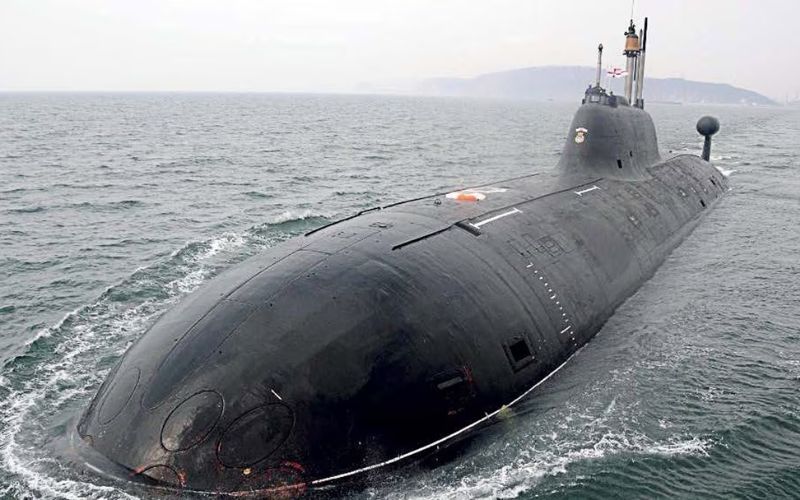Indian Submarine Surfaces Near China Chokepoint Despite 4:1 Odds; Experts Express Concern Over Shortage

Indian Submarine Surfaces Near China Chokepoint: Indian Navy submarine prowess has been demonstrated in the last two days. In the Western Indian Ocean region, eight of its submarines operated together, a first in three decades, and one of its Scorpene submarines sailed to the Andaman Nicobar Islands, overlooking the Malacca Strait, a critical choke point for China.
There is a dichotomy between the ambitions and capabilities of the Indian Navy's submarine force. Submariners have an adage - "There are two types of vessels in the sea - submarines and targets."
There are still 76 platforms in China's submarine force, including 8 SSBNs (ballistic missile submarines), 13 SSNs (nuclear-powered attack submarines), and 55 diesel-electric submarines (SSKs).
A Kalvari class (Scorpene) submarine visited INS Baaz over the weekend, India's last base in the Eastern Indian Ocean Region. Although it is a significant milestone for the Kalvari class submarines, presenting it as a representative of the Indian Navy's reach leaves a lot to be desired as Chinese submarines often penetrate the Indian Ocean.
During a joint maritime patrol in the Western Indian Ocean region in November 2023, a Type-093 Song class diesel-electric submarine of the PLA-Navy participated.
In the Nicobar group of islands, India's southernmost port, Campbell Bay, was visited by a Kalvari-class submarine on March 24. The port overlooks the Strait of Malacca, a narrow lane connecting the Indian Ocean with the South China Sea. It is of strategic and economic importance to China.
It is only 145 kilometers from Indonesia and controls the 6-degree shipping channel between Great Nicobar and the Indonesian island of Sumatra.
The Indian Navy has never visited a strategic port with a submarine of this class, thus expanding its reach far away from the mainland. As a result, planners will be able to deploy stealth submarines rapidly in our areas of interest and beyond, the Eastern Naval Command said on its social media page. In the post, it was made clear that this was only the first time the class had visited this port.
The Indian Air Force (IAF) landed its C-130 J special operations aircraft at INS Baaz in 2022 after expanding the runway on the airstrip to accommodate maritime surveillance planes like Boeing P-8I.
According to an official who refused to be identified, the Chinese have already sent diesel submarines to the Indian Ocean Rim. Indian submarines have reached the region in the past. Approximately 1500 kilometers from mainland India, Campbell Bay is the same distance at which the Indian Navy conducted its anti-piracy operation near the Gulf of Aden inducting marine commandos via paradrop.
In a recent exercise in the Arabian Sea, the Indian Navy released stunning photographs of its submarine pod on the western seaboard.
Indian Navy Chief Admiral Hari Kumar previously revealed that 11 conventional submarines had been deployed simultaneously in various parts of the Indian Ocean Region.
To maintain safety and stability in the oceans, Operation Sankalp has dispelled the myth of short and swift operations. “We conduct operations at a very fast pace, and we operate 11 submarines and 30 warships across the ocean to cover all areas of interest,” Kumar explained.
In a recently concluded exercise in the Arabian Sea, eight submarines demonstrated their high operational readiness along the Western Seaboard.
During the last two decades, the Indian Navy has had the largest number of operational submarines. However, the submarine arm has suffered from dwindling strength, accidents, and write-offs. In addition to the six submarines built recently, the rest are over 30 years old and are nearing their decommissioning date, despite the requirement for 24 conventional submarines.
India's submarine capability remains woefully short despite Beijing's clear intentions to dominate the Indo-Pacific and, more specifically, the Indian Ocean Region. In addition to conventional submarines, it has one SSBN (INS Arihant) on lease from Russia and one SSN Akula class submarine on lease.
There are five Scorpene class submarines in the Indian conventional submarine fleet (French), four HDW submarines (German), and seven Kilo-class submarines (Russian).
Indian Navy submarines are not operationally available. As a general rule, two vessels are needed for every vessel that is operating—one preparing for deployment, and one standing down from recent operations. Keeping up with maintenance and crew rest and training schedules requires the numbers to be sufficient.
During peacetime, only one-third of the fleet is expected to be deployed, but more vessels can be deployed during wartime, but realistic assessments need to be made. In addition to inducting submarines into its fleet, the Chinese Navy is also equipping Pakistan with advanced technology.
In comparison with Pakistan's fleet, the Indian Navy will be better positioned by adopting AIP technology. Under a US$5 billion deal with China, Pakistan is also expected to receive eight 39 A Yuan-class AIP-powered submarines by the end of 2023 (PNS Khalid, Saad, and Hamza).
Despite having 17 conventional submarines in its fleet by next year, the older Kilo-class submarines have low availability rates.
One of the Russian submarines was decommissioned already, the second was refurbished and gifted to Myanmar, and the third was lost in 2013.
Check Out: Who Is Viatina? The World’s Most Expensive Cow, Valued At Rs 40 Crore
For breaking news and live news updates, like us on Facebook or follow us on Twitter and Instagram. Read more on Latest World News on The National Bulletin


